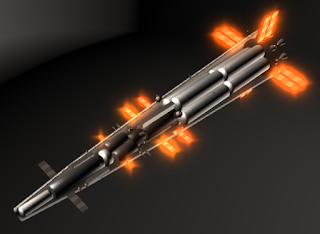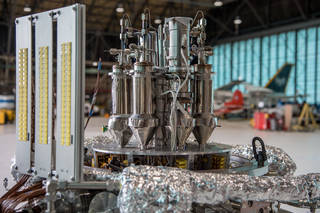Cooling In Space
So thermodynamics says that no engine can be 100% efficient, it means that we can't possibly make an engine which can convert all the energy that is stored in its fuel into usable work. We are going to produce some waste in the form of heat. This wast heat has to be dumped out of the engine or else the engine will melt. This fact doesn't just apply for engines but for any type of mechanism as well.
Cooling on earth is a fairly simple thing because most things are cooled by the air, anything which can't be cooled statically by air has to aided by a air radiator. Basically the heat from a heat source is absorbed by a coolant which then carries the heat into a mesh of coolant pipes (an water to air heat exchanger) which increases the surface area in which the coolant through the pipes is exposed to the air. A fan can be added to up the flow of air. This is a very simple liquid cooled system which works for most kinds of things on earth.If more cooling is required then we can simply get a bigger mesh, increase the surface area or pump air faster.
Its fairly obvious why this kind of a cooling system won't work in space, no atmosphere. Air cooling or any kind of conductive cooling won't work in space so engineers have to come up with more unique ideas to cool a space craft. Enter radiative cooling, its basically the same thing as a conductive radiator till the air to water heat exchanger. In place of that we just have pipes exposed to space and nothing more. So what is the heat being dumped into?
When something gets hot it releases what is called as "black body radiation" basically it glows, the light or radiation that it produces takes heat away from it. Sometimes the temperature is so less that the light produced is not visible to human eye. We can use this property of things to our advantage.
So if we pumped hot coolant through pipes extended into space which will make them hot and glow and the coolant will cool down, all well and good but there are some problems. Radiation is a very bad way of releasing heat as it's not as efficient as conductive cooling. Also, radiators have to work at very high temperatures to even start working. Increasing surface area is an option but the pipes should be as far away as possible or else the heat released by one pipe will be absorbed by nearby pipes, so can't just stack pipes on top of each other. If we try to increase surface area then we would increase the weight of the radiator which would eat into the payload that we carry.
So the only way to increase heat dissipation is to have a higher operating temperature, radiators start to become really really good as we up the heat, because radiation increases exponentially with heat, if we double the temperature then the energy released is quadrupled. But still there is a problem, heat flow only from hotter to colder side whatever temperature we run the radiator the heat source has to be hotter. If the heating source is some kind of an engine or generator its even a big problem because the more efficient an engine is the higher the temperature difference in its intake and exhaust is going to be. So for example if we want to run a radiator at say 2000°K the output of the nuclear reactor has to be more that 2000°K(say 2200°K) not just that if we expect any realistic efficiency from it then the operating temperature of the reactor has to be well over 3000°K (temperature difference of 3000-2200°K would probably give us <20% thermal efficiency).
So that pretty much summarises the problem of cooling is space, for better radiators we need high temperature,for higher temp radiators we need high temp exhaust, for high temp exhaust we need high operating temp or low temp difference which is not efficient and produces more heat and the problem goes on.
So yeah cooling is difficult but there is something that we can sort of do. There are different types of radiators which can increase the surface area without increasing weight, they might even be lighter than the conventional solid radiator. Enter liquid droplet radiator. So higher surface area is better. Why don't we just sprinkle the coolant into space well obviously because we will run out of it but if we recover the coolant. That's exactly what a liquid droplet radiator is, we just sprinkle the coolant into space. The high surface area of droplets helps heat dissipation and the whole system of sprinkler and collector weighs way less than a solid radiator.
The radiator basically works by a pump pumping the coolant into a sprinkler very similar to a fuel injector, controlling the path of coolant specially under acceleration is important so very high pressures are used. The coolant floats in space for a sec and then hits the collector which is basically a funnel it recovers the coolant which has cooled a bit and puts it back into the system. As you probably can guess some of the coolant may get lost but its not significant and we can have coolant is storage. Also this isn't a very fragile system anything from space dust to railgun shots can very easily damage it. There are many different kinds of radiators which follow the same principle of dumping hot stuff into space and recovering them some how, there are some very unique designs which control the droplet with magnets.
Anyways, cooling in space forever is going to be a problem in space there aren't any good ways of solving it. The only way to solve the problem of cooling is probably to produce less of it, if we can make an engine which produces very less heat or is cooled by an open cycle entirely that would be the best system. We are very long way away from a 100% efficient engine but space agencies are planning to send nuclear reactors on satellites and as of now they are using solid radiators, in future they would have to go for better radiators and we have good hopes for them.





Comments
Post a Comment